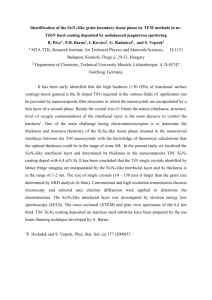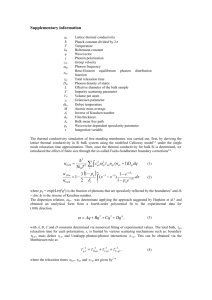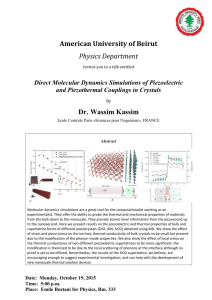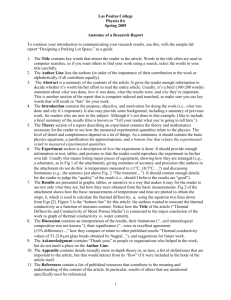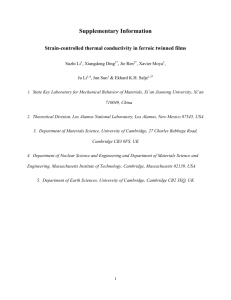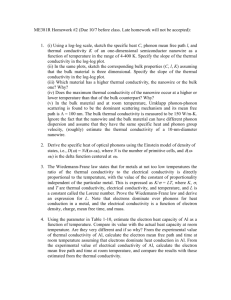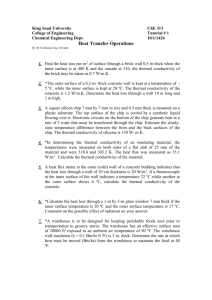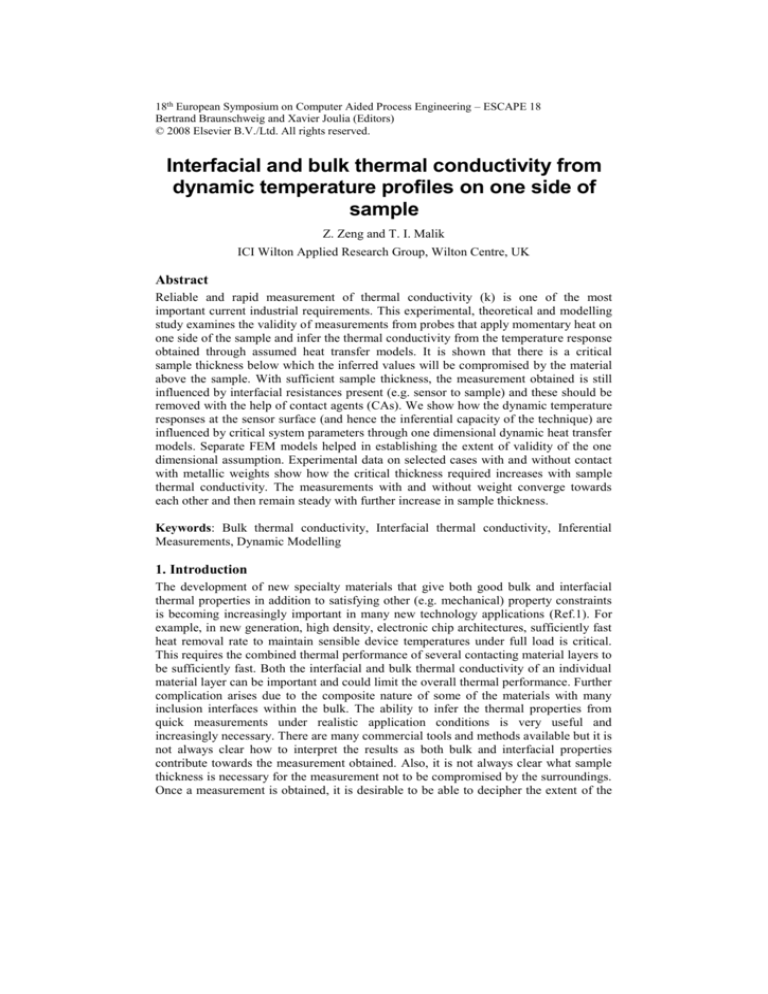
18th European Symposium on Computer Aided Process Engineering – ESCAPE 18
Bertrand Braunschweig and Xavier Joulia (Editors)
© 2008 Elsevier B.V./Ltd. All rights reserved.
Interfacial and bulk thermal conductivity from
dynamic temperature profiles on one side of
sample
Z. Zeng and T. I. Malik
ICI Wilton Applied Research Group, Wilton Centre, UK
Abstract
Reliable and rapid measurement of thermal conductivity (k) is one of the most
important current industrial requirements. This experimental, theoretical and modelling
study examines the validity of measurements from probes that apply momentary heat on
one side of the sample and infer the thermal conductivity from the temperature response
obtained through assumed heat transfer models. It is shown that there is a critical
sample thickness below which the inferred values will be compromised by the material
above the sample. With sufficient sample thickness, the measurement obtained is still
influenced by interfacial resistances present (e.g. sensor to sample) and these should be
removed with the help of contact agents (CAs). We show how the dynamic temperature
responses at the sensor surface (and hence the inferential capacity of the technique) are
influenced by critical system parameters through one dimensional dynamic heat transfer
models. Separate FEM models helped in establishing the extent of validity of the one
dimensional assumption. Experimental data on selected cases with and without contact
with metallic weights show how the critical thickness required increases with sample
thermal conductivity. The measurements with and without weight converge towards
each other and then remain steady with further increase in sample thickness.
Keywords: Bulk thermal conductivity, Interfacial thermal conductivity, Inferential
Measurements, Dynamic Modelling
1. Introduction
The development of new specialty materials that give both good bulk and interfacial
thermal properties in addition to satisfying other (e.g. mechanical) property constraints
is becoming increasingly important in many new technology applications (Ref.1). For
example, in new generation, high density, electronic chip architectures, sufficiently fast
heat removal rate to maintain sensible device temperatures under full load is critical.
This requires the combined thermal performance of several contacting material layers to
be sufficiently fast. Both the interfacial and bulk thermal conductivity of an individual
material layer can be important and could limit the overall thermal performance. Further
complication arises due to the composite nature of some of the materials with many
inclusion interfaces within the bulk. The ability to infer the thermal properties from
quick measurements under realistic application conditions is very useful and
increasingly necessary. There are many commercial tools and methods available but it is
not always clear how to interpret the results as both bulk and interfacial properties
contribute towards the measurement obtained. Also, it is not always clear what sample
thickness is necessary for the measurement not to be compromised by the surroundings.
Once a measurement is obtained, it is desirable to be able to decipher the extent of the
2
Z Zeng et al
different contributions but by definition this is difficult as the inferential measurement
technique itself is based on the assumption of no interfacial resistance.
In this paper, we deal with these issues through focus on single sided, thermal
conductivity probes (e.g. see Refs.2,3) that apply a small amount of heat on one side of
the sample. Such probes can give a rapid measurement in a matter of seconds and can
be used both in the laboratory and within industrial unit operations. In the latter case,
the inferred k may be an indicator of a given state in the process and used as an aid to
process and quality control. The rate of change of temperature at the probe depends on
both the sample and probe properties. The surrounding conditions, e.g. ambient
temperature and humidity, if weights are placed above the sample and contact agent
(CA) is used between the probe and the sample could also impact the readings. It is
surmised that a sample with higher k, heat capacity and density will have a greater
ability to leak out the heat from the source. Thus under standard calibrated conditions,
the rate of change of temperature for a given sample can be used to deduce its thermal
conductivity given sample thermal capacity and probe properties are known.
We show, for the case, where effective one dimensional heat transfer can be assumed,
how the inferring of the bulk thermal conductivity requires a minimum thickness of the
sample and minimisation of any interfacial thermal resistance, in particular between the
sensor and the sample. However, these conditions may not be met or the key interest
may indeed be in the interfacial conductance (Cc) itself. For an unlayered sample, there
is a second interfacial resistance, that of the sample to the air that impacts on the
temperature transient for sufficiently thin samples. We define the critical thickness for
the sample as the largest value that gives feedback to the sensor under the test
conditions used and within the test time domain. We seek to know how this is
influenced by the material’s properties. We define an equivalent material (Fig.1) at the
critical thickness that has no interfacial resistance but gives the same measurement as
the material with interfacial resistance. As far as the probe is concerned, it does not
know about any interfaces, it works out an overall thermal conductivity value based on
the temperature dynamic obtained. If assuming that the probe is capable of returning a
legitimate overall equivalent conductivity then simple algebraic expressions can be used
to decipher the individual bulk and interfacial contributions. However, in practice the
probe value will only be an approximation to this ideal, as there are non-linearities in
the inferential calculation and the exact critical thickness will also be required.
Nevertheless, despite these limitations, the algebraic equations could offer some quick
indication of the interfacial conductivity providing the bulk k is known or determined
from a separate test. This is better than having no measurement based estimate at all.
2. Sensitivity of temperature change rate at sensor
It is the sensitivity of temperature change rate to the thermal conductivity that
determines the capability of such a device to infer the same. This will be helped if the
probe itself is made of material of relatively low thermal conductivity, thus the bulk of
heat will travel to the sample. For a very thick sample the heat will penetrate only the
sample and the source temperature will not be influenced by the air or other material
above. The higher the sample thermal conductivity the faster will be the rate of heat
transfer for a given temperature driving force. The higher the thermal capacity of the
sample (and hence its specific heat and density) the longer it will take for its
temperature to rise and hence a higher temperature driving force will be maintained for
longer. On the other hand, to increase the sensitivity at the probe itself, its thermal
capacity should be relatively low, to give relatively high temperature changes there.
Interfacial and bulk thermal conductivity from dynamic temperature profiles on one side
of sample
3
This gives the concept of thermal feedback to the source point, where the temperature
dynamic is influenced by properties and events further away within the short time
domain of the test. See (Ref.2,3) for typical probe construction rationale used and the
method used to infer the thermal conductivity. See Fig.1 for equivalent samples as
‘seen’ by the probe and Fig.2 for a schematic of a system for the dynamic model.
2
l1 T
2
Ti 2 Sample
q
T
i1
l 2 T 1 Sample 1
q
T1
k 2 Cc5
Air
Sample Materials
K Sam2
10 Slices
k1
q
Ti
Cc2
Sensor
K Sam1
T 1 Sensor
Sensor
Power introduced half way
Cc1
below sample
T2
l
Equivalent K Sen
Sample
(l 1 l 2)
ko
Sample
Cc3
q
Matrix material
T1
K Mat
only 1 slice
T 1 Sensor
Extent of Model Domain
Cc4
Figure 1 – Single, two layered and equivalent Figure 2 – Schematic showing probe and two layered sample
samples.
(sliced for 1D dynamic model).
T2
Sample
l
k1
q Cc A (T 1 Ti )
ko
l
ko
q
l
ko
q
l
ko
1
lC c
q
k1
A (Ti T 2) ... (1)
l
A (T 1 T 2) ... (2)
A (T 1 Ti Ti T 2) ... (3)
q
ko
l
Aq
... (4)
CcA
l
k1 A
ko
kok 1
... (5)
Cc
... (6)
k1
l ( k 1 k 0)
A
q Cc A (Ti1 Ti 2)
k1
k2
A (T 1 Ti1)
A (Ti 2 T 2) ... (7)
l1
l2
ko
A (T 1 T 2) ... (8)
(l1 l 2)
ko
q
A (T 1 Ti1 Ti1 Ti 2 Ti 2 T 2) ... (9)
(l1 l 2)
q
ko
l1
ko
ko
l2
q
Aq
A
Aq
... (10)
(l1 l 2)
k 1 A (l1 l 2) CcA (l1 l 2)
k2A
ko
l1
1
l2
1
1
[
] ...(11)
Cc
... (12)
(l1 l 2) l1 l 2
(l1 l 2) k 1 Cc k 2
[
]
ko
k1 k 2
q
Equations Set 1 – Single sample with contact Equations Set 2 – Two samples above each other with single
resistance (1/CC) with sensor
contact resistance (1/CC) between them.
Fig. 1 shows the equivalence between a single layered sample, a two layered sample
and an equivalent sample as viewed by the probe assuming the overall sample thickness
is at critical for the measurement. The top left shows how a single sample will conduct
heat once it has traversed the interface (thus T 1 and Ti are different giving temperatures
at the two sides of the interface). For the two layered case shown in top right, an
additional interface and temperature variables are introduced. Both cases can be
transformed to the equivalent case where there is only a single contiguous material
without interfacial resistance. The equations are derived for a single sample case with
one interfacial resistance in Eq.1 to Eq.6. Similarly, Eq.7 to Eq.12 repeat the derivation
for the two sample case with only one interfacial resistance between the two samples
(that between sensor and sample 1 is assumed as zero). Note strict conditions are
required for these relationships to be valid for any of the probe measurements. Even if
the sample thickness is exactly right, the accuracy depends on the capability of the
probe to return an equivalent overall value. It will need further work to establish that.
3. Dynamic modelling sensitivity studies.
Both finite element (FEM) and equation based lumped dynamic models have been used
to understand the behaviour of a thermal conductivity probe and its sensitivity to
different parameters for the sample and the interfaces. Fig. 3 shows example outputs
from axi-symmetrical, finite element models and show temperature maps at given time
snapshots with a) showing a typical case of interfacial resistance and sample
conductivity. Fig.3 (b) shows the case when the interfacial resistance is zero and the
4
Z Zeng et al
bulk k of the sample is very high. The heat disperses very quickly when it enters the
sample and hence the sample temperature remains low above the interface (shown by
the horizontal line). In Fig. 3 (c), Cc is zero and the sample once again remains at low
temperature, but in this case it is due to no heat being transferred there. The FEM
models show that in the central part of the probe, the assumption of one dimensional
heat transfer up and down the model domain is reasonable. Such assumptions are used
in the algorithms used for inferring the thermal conductivity from the probe.
Temperature Responses
Temp C
25.7
25.6
Sensor k5 3mm
25.5
Sensor k17 3mm
Surf k5 3mm
25.4
Surf k17 3mm
25.3
Sensor k5 6mm
25.2
Sensor k17 6mm
25.1
Surf k5 6mm
25
Surf k17 6mm
24.9
0
a
b
0.2
c
0.4
0.6
Time (S)
Figure 3 FEM dynamic model snapshots Figure 4 One dimensional, sliced, dynamic model
with a) medium Cc b) v. high Cc and sensitivity results (surface and sensor temperature
responses with k and sample thickness varying
sample k and c) 0 Cc
25.7
Temp C
25.6
25.5
SensRun1
25.4
SensRun2
25.3
SensRun3
25.2
SensRun4
25.1
SensRun6
25
24.9
0
0.1
0.2
0.3
0.4
0.5
0.6
Time S
Figure 5 – Dynamic temperature sensitivity results for two samples 1) Medium
Cc1+Cc2 2) High Cc2 3) High Cc1 4) Low sample 2 k and 5) Very low Cc1
Assuming the validity of the one dimensional heat flow assumption, it is possible to
carry out dynamic model analysis through one dimensional heat transfer models. These
can be implemented readily in Equation Based modelling environments (e.g. see Ref.4).
(We used Aspen Custom Modeller, Ref.5) for implementing these models. Fig. 2 above
shows the general schematic used for such a model showing that the sample is split into
a number of slices. These can be as many as required for a given accuracy, in our
studies 10 were used. The bulk k of each sample can be set separately as well as for the
sensor and the matrix material of the probe. A number of Cc values are specified in the
model with Cc4 and Cc5 representing the interfacial conductance to the surrounding air.
Note that it is assumed that the sides of the probe are well insulated. In the model the
surrounding air velocity can be set and the Cc can be obtained as a function of this
through typical convective heat transfer correlations. The model works out a differential
heat balance for each slice taking into account the bulk and interfacial resistances
present and works out a temperature for each slice and interface. These temperatures
provide the driving forces for the heat transfer equations between the slices and through
the interfaces. Some results for a single sample case are shown in Fig.4. Here both
sensor temperature (the top four lines) response and the surface temperature response
are shown for the four cases (two thicknesses and two bulk k values). The response is
far more sensitive to k than it is to sample thickness in these cases. The surface response
Interfacial and bulk thermal conductivity from dynamic temperature profiles on one side
of sample
5
is biggest as expected for the highest k and thinnest sample case. Similarly, Fig.5 shows
the dynamic model results for the case with two samples, each modelled as 10 slices.
The sensitivities to the two key Cc that between sensor and sample 1 and between the
two samples are shown. The curve with the highest slope is obtained when C c1 is very
low, thus not allowing heat to leak out. This would also lead to a low ko value.
10
14
12
Multilayered Material A films
Stacked by 25 um
Stacked by 103 um
Stacked by 177 um
1
10
8
6
0.1
Multilayered Material B films
With conducting weight
With insulating weight
Without weight
4
ko of High Conductive Samples (W/m.K)
ko of Low Conductive Samples (W/m.K)
16
Singlelayered Material A films
With metal weight
Without metal weight
2
0
100
200
300
400
500
2000
4000
6000
8000
Thickness (m)
Figure 6 – Apparent thermal conductivities ko from probe
4. Experimental Study.
Here we report on selected measurements using a probe. The sample was either directly
placed on the probe or with a CA in between to increase Cc. There may be a metal
weight (to give clamping pressure) placed above the sample either in contact via a CA
or through a thermally insulating layer (foam). Fig. 6 shows the ko values inferred for a
low k material A and a relatively high k material B. Multi-layered samples of different
thicknesses have been combined together with CA to obtain the overall thickness shown
in the diagram. The descending line is for the case where there is direct contact with
metal weights while the ascending line is without. It shows that effective CA has been
obtained as there is no significant difference between the different points with different
number of layers. It indicates that the critical thickness of material A is only about 400
m since the ko values measured converge on each other and are no longer affected by
the surroundings. For material B with a much higher k, the critical thickness has
increased to 8 mm. The inner of the bottom curves has the same weights but applied via
a thermally insulating foam while the bottom curve is obtained without any weights. For
this material, thermal properties of the weight gave much stronger impact than it did for
improving interfacial contact when directly in contact, below the critical thickness.
Table 1 shows the impact of CA on materials C and D. C is rigid and the impact of
pressure is minimal but CA makes a large change to the measured ko. Material D is soft
and under its own weight can achieve good interfacial compliance so that there is not
much impact when additional pressure applied without CA. CA without pressure has in
fact reduced measured ko value and this may be because the conductivity of the CA
itself has influenced the reading. However, as expected, the excess CA is squeezed out
when additional weight applied and the maximum ko is obtained. Clearly, the interfacial
resistance for material C is much greater than material D. In all cases, a strategy to
measure bulk k involves the application of an effective CA and weight if appropriate to
remove as far as possible the interfacial resistance. Thus with C, this would give the
6
Z Zeng et al
bulk conductivity as 0.6 Watt/mK. Eq. 6 can be used to obtain an approximate Cc for the
case without CA. For material C, this gives Cc as about 280 Watts/m2K. It will be much
higher for Material D. As mentioned above there are many caveats in relation to use of
Eq. 6. For example, sample thickness must be at the right value and the measurement to
be the final equilibrium value. (There are cases with soft materials where a transient
improvement to ko is obtained as the material settles under its own weight).
Material C, Rigid sample
Material D, soft sample
Contact agent No contact agent Contact agent No contact agent
Pressure
0.60
0.29
5.87
5.71
No pressure
0.60
0.29
5.19
5.70
Table 1 – The impact of contact agent on ko (W/mK) measurements for Materials C and D.
5. Conclusion
It has been shown that there is a critical thickness above which the inferred k values
from a single sided probe are not influenced by the k of the surrounding materials. The
critical thickness does depend upon the bulk k of the sample as well as the Cc with the
sensor providing the heat. For a sample case with k about 10 Watt/mK the critical
thickness is 8 mm. This reduced to only 400 m for a sample with bulk k less than 1
Watt/mK. A way to have a first approximation of interfacial resistance is to measure the
ko with both CA applied or not. Assuming effective CA is applied, the measurement
approximates to the material bulk k. This can then be used to back calculate the
interfacial resistance assuming the measurement without CA gives an equivalent overall
conductivity. Future publications will examine in more detail the extent to which these
types of probes are capable of giving an accurate equivalent k value. Good methods
could enable reliable and fast measurements for Cc. The critical thickness can be
obtained by repeating the ko measurements with different sample thicknesses, if
necessary with layered samples with CA in between. Soft layered materials were found
amenable to relatively good conformance even without CA due to their own weight but
the harder samples could give much bigger changes in ko value upon applying CA. The
bulk k is closest to the ko value when effective CA applied. The impact of clamping
pressure highly depends on the modulus of the material with softer materials influenced
by the pressure, possibly in a time dependent manner. Dynamic modelling based
sensitivity studies have shown the potential for such techniques also to detect other
interfacial resistances e.g. between two samples assuming that CA is applied at the first
interface. However, further development is also subject to the above constraints on the
ability of the probe to give an accurate overall system conductivity.
References
[1] “Thermal Contact Conductance”, C. V. Madhusudana, Springer Mechanical
Engineering Series, ISBN 0-387-94534-2 1996 Springer-Verlag New York Inc.
[2] “Direct Thermal Conductivity Measurement Technique”, Mathis, N. and C.
Chandler, United States Patent, US 6,676,287 B1, 2004.
[3] “New Transient Non-Destructive technique measures thermal effusivity and
thermal diffusivity, Mathis, N.E. , Proc. 25th Int. Thermal Conductivity Conf., 1999.
[4] “Application of same equation based model from steady state design to control
system analysis and operator training”, Garlick, S., Malik, T.I. and Tyrrell, M.J.,
Computers chem. Engng. Vol.18, Suppl., pps493-s497, 1994, Pergamon press.
[5] http://www.aspentech.com/products/aspen-custom-modeler.



